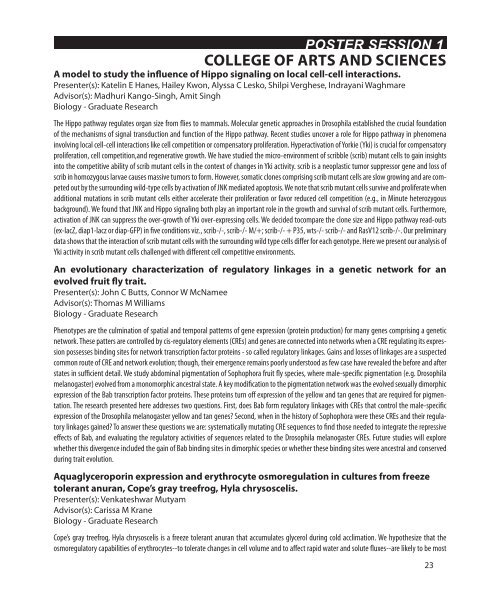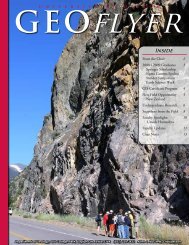Stander Symposium abstract book - University of Dayton
Stander Symposium abstract book - University of Dayton
Stander Symposium abstract book - University of Dayton
Create successful ePaper yourself
Turn your PDF publications into a flip-book with our unique Google optimized e-Paper software.
POSTER SESSION 1<br />
COLLEGE OF ARTS AND SCIENCES<br />
A model to study the influence <strong>of</strong> Hippo signaling on local cell-cell interactions.<br />
Presenter(s): Katelin E Hanes, Hailey Kwon, Alyssa C Lesko, Shilpi Verghese, Indrayani Waghmare<br />
Advisor(s): Madhuri Kango-Singh, Amit Singh<br />
Biology - Graduate Research<br />
The Hippo pathway regulates organ size from flies to mammals. Molecular genetic approaches in Drosophila established the crucial foundation<br />
<strong>of</strong> the mechanisms <strong>of</strong> signal transduction and function <strong>of</strong> the Hippo pathway. Recent studies uncover a role for Hippo pathway in phenomena<br />
involving local cell-cell interactions like cell competition or compensatory proliferation. Hyperactivation <strong>of</strong> Yorkie (Yki) is crucial for compensatory<br />
proliferation, cell competition,and regenerative growth. We have studied the micro-environment <strong>of</strong> scribble (scrib) mutant cells to gain insights<br />
into the competitive ability <strong>of</strong> scrib mutant cells in the context <strong>of</strong> changes in Yki activity. scrib is a neoplastic tumor suppressor gene and loss <strong>of</strong><br />
scrib in homozygous larvae causes massive tumors to form. However, somatic clones comprising scrib mutant cells are slow growing and are competed<br />
out by the surrounding wild-type cells by activation <strong>of</strong> JNK mediated apoptosis. We note that scrib mutant cells survive and proliferate when<br />
additional mutations in scrib mutant cells either accelerate their proliferation or favor reduced cell competition (e.g., in Minute heterozygous<br />
background). We found that JNK and Hippo signaling both play an important role in the growth and survival <strong>of</strong> scrib mutant cells. Furthermore,<br />
activation <strong>of</strong> JNK can suppress the over-growth <strong>of</strong> Yki over-expressing cells. We decided tocompare the clone size and Hippo pathway read-outs<br />
(ex-lacZ, diap1-lacz or diap-GFP) in five conditions viz., scrib-/-, scrib-/- M/+; scrib-/- + P35, wts-/- scrib-/- and RasV12 scrib-/-. Our preliminary<br />
data shows that the interaction <strong>of</strong> scrib mutant cells with the surrounding wild type cells differ for each genotype. Here we present our analysis <strong>of</strong><br />
Yki activity in scrib mutant cells challenged with different cell competitive environments.<br />
An evolutionary characterization <strong>of</strong> regulatory linkages in a genetic network for an<br />
evolved fruit fly trait.<br />
Presenter(s): John C Butts, Connor W McNamee<br />
Advisor(s): Thomas M Williams<br />
Biology - Graduate Research<br />
Phenotypes are the culmination <strong>of</strong> spatial and temporal patterns <strong>of</strong> gene expression (protein production) for many genes comprising a genetic<br />
network. These patters are controlled by cis-regulatory elements (CREs) and genes are connected into networks when a CRE regulating its expression<br />
possesses binding sites for network transcription factor proteins - so called regulatory linkages. Gains and losses <strong>of</strong> linkages are a suspected<br />
common route <strong>of</strong> CRE and network evolution; though, their emergence remains poorly understood as few case have revealed the before and after<br />
states in sufficient detail. We study abdominal pigmentation <strong>of</strong> Sophophora fruit fly species, where male-specific pigmentation (e.g. Drosophila<br />
melanogaster) evolved from a monomorphic ancestral state. A key modification to the pigmentation network was the evolved sexually dimorphic<br />
expression <strong>of</strong> the Bab transcription factor proteins. These proteins turn <strong>of</strong>f expression <strong>of</strong> the yellow and tan genes that are required for pigmentation.<br />
The research presented here addresses two questions. First, does Bab form regulatory linkages with CREs that control the male-specific<br />
expression <strong>of</strong> the Drosophila melanogaster yellow and tan genes? Second, when in the history <strong>of</strong> Sophophora were these CREs and their regulatory<br />
linkages gained? To answer these questions we are: systematically mutating CRE sequences to find those needed to integrate the repressive<br />
effects <strong>of</strong> Bab, and evaluating the regulatory activities <strong>of</strong> sequences related to the Drosophila melanogaster CREs. Future studies will explore<br />
whether this divergence included the gain <strong>of</strong> Bab binding sites in dimorphic species or whether these binding sites were ancestral and conserved<br />
during trait evolution.<br />
Aquaglyceroporin expression and erythrocyte osmoregulation in cultures from freeze<br />
tolerant anuran, Cope’s gray treefrog, Hyla chrysoscelis.<br />
Presenter(s): Venkateshwar Mutyam<br />
Advisor(s): Carissa M Krane<br />
Biology - Graduate Research<br />
Cope’s gray treefrog, Hyla chrysoscelis is a freeze tolerant anuran that accumulates glycerol during cold acclimation. We hypothesize that the<br />
osmoregulatory capabilities <strong>of</strong> erythrocytes--to tolerate changes in cell volume and to affect rapid water and solute fluxes--are likely to be most<br />
23

















